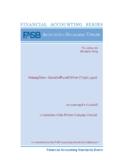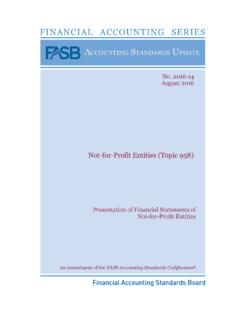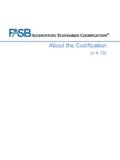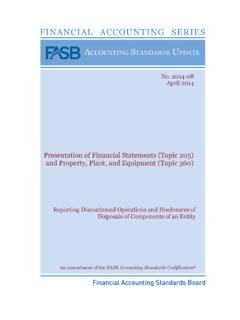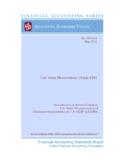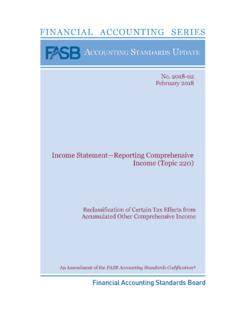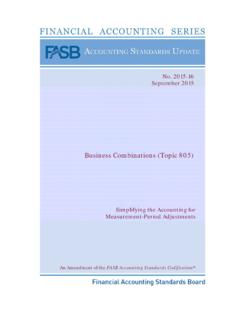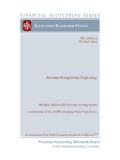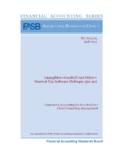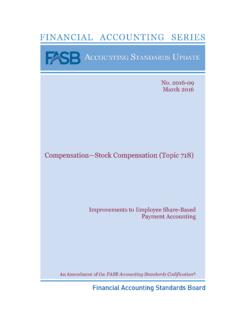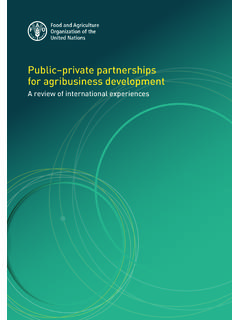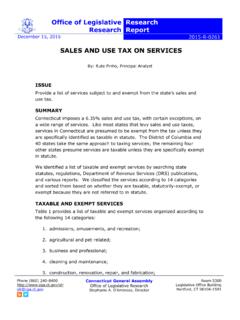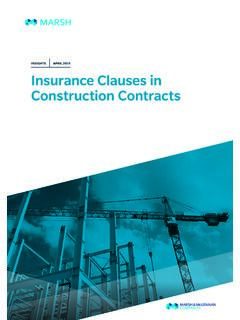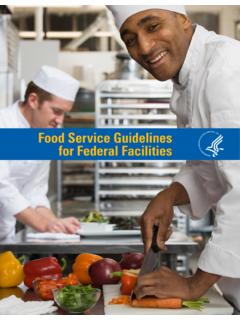Transcription of Revenue from Contracts with Customers (Topic 606)
1 Revenue from Contracts with Customers (Topic 606) No. 2016-10 April 2016 Identifying Performance Obligations and Licensing An Amendment of the FASB Accounting Standards Codification The FASB Accounting Standards Codification is the source of authoritative generally accepted accounting principles (GAAP) recognized by the FASB to be applied by nongovernmental entities. An Accounting Standards Update is not authoritative; rather, it is a document that communicates how the Accounting Standards Codification is being amended. It also provides other information to help a user of GAAP understand how and why GAAP is changing and when the changes will be effective. For additional copies of this Accounting Standards Update and information on applicable prices and discount rates contact: Order Department Financial Accounting Standards Board 401 Merritt 7 PO Box 5116 Norwalk, CT 06856-5116 Please ask for our Product Code No.
2 ASU2016-10. FINANCIAL ACCOUNTING SERIES (ISSN 0885-9051) is published monthly with the exception of January and October by the Financial Accounting Foundation, 401 Merritt 7, PO Box 5116, Norwalk, CT 06856-5116. Periodicals postage paid at Norwalk, CT and at additional mailing offices. The full subscription rate is $255 per year. POSTMASTER: Send address changes to Financial Accounting Standards Board, 401 Merritt 7, PO Box 5116, Norwalk, CT 06856-5116. | No. 434 Copyright 2016 by Financial Accounting Foundation. All rights reserved. Content copyrighted by Financial Accounting Foundation may not be reproduced, stored in a retrieval system, or transmitted, in any form or by any means, electronic, mechanical, photocopying, recording, or otherwise, without the prior written permission of the Financial Accounting Foundation.
3 Financial Accounting Foundation claims no copyright in any portion hereof that constitutes a work of the United States Government. An Amendment of the FASB Accounting Standards Codification No. 2016-10 April 2016 Revenue from Contracts with Customers (Topic 606) Identifying Performance Obligations and Licensing Accounting Standards UpdateFinancial Accounting Standards Board Accounting Standards Update 2016-10 Revenue from Contracts with Customers (Topic 606) Identifying Performance Obligations and Licensing April 2016 CONTENTS Page Numbers Summary .. 1 6 Amendments to the FASB Accounting Standards Codification .. 7 58 Background Information and Basis for Conclusions ..59 86 Amendments to the XBRL Taxonomy.
4 87 1 Summary Why Is the FASB Issuing This Accounting Standards Update (Update)? On May 28, 2014, the FASB and the International Accounting Standards Board (IASB) issued a converged standard on recognition of Revenue from Contracts with Customers . In June 2014, the FASB and the IASB (collectively, the Boards) announced the formation of the FASB-IASB Joint Transition Resource Group for Revenue Recognition (TRG). One of the objectives of the TRG is to inform the Boards about potential implementation issues that could arise when organizations implement the new Revenue guidance. The TRG also assists stakeholders in understanding specific aspects of the new Revenue guidance. The TRG does not issue authoritative guidance.
5 Instead, the Boards evaluate the feedback received from the TRG and other stakeholders to determine what action, if any, is necessary for each potential implementation issue. Implementation questions submitted to the TRG and discussions at TRG meetings informed the Board about a few issues in the guidance on identifying performance obligations and licensing. Those issues include: 1. Identifying Performance Obligations: a. When identifying performance obligations, whether it is necessary to assess whether promised goods or services are performance obligations if they are immaterial in the context of the contract b. Determining whether promised goods and services are separately identifiable (that is, distinct within the context of the contract ) c.
6 Determining whether shipping and handling activities are a promised service in a contract or are activities to fulfill an entity s other promises in the contract . 2. Licensing: a. Determining whether the nature of an entity s promise in granting a license is to provide a right to access the entity s intellectual property, which is satisfied over time and for which Revenue is recognized over time, or to provide a right to use the entity s intellectual property, which is satisfied at a point in time and for which Revenue is recognized at a point in time b. The scope and applicability of the guidance about when to recognize Revenue for sales-based or usage-based royalties promised in exchange for a license of intellectual property c.
7 Distinguishing contractual provisions that require an entity to transfer additional licenses (that is, rights to use or access intellectual property) to a customer from contractual provisions that define the 2 attributes of a promised license (for example, restrictions of time, geographical region, or use). To address those issues, the Board decided to add a project to its technical agenda to improve Topic 606, Revenue from Contracts with Customers , by reducing: 1. The potential for diversity in practice at initial application 2. The cost and complexity of applying Topic 606 both at transition and on an ongoing basis. Who Is Affected by the Amendments in This Update? The amendments in this Update affect entities with transactions included within the scope of Topic 606.
8 The scope of that Topic includes entities that enter into Contracts with Customers to transfer goods or services (that are an output of the entity s ordinary activities) in exchange for consideration. What Are the Main Provisions and How Are Those an Improvement? The core principle of the guidance in Topic 606 is that an entity should recognize Revenue to depict the transfer of promised goods or services to Customers in an amount that reflects the consideration to which the entity expects to be entitled in exchange for those goods or services . To achieve that core principle, an entity should apply the following steps: 1. Identify the contract (s) with a customer . 2. Identify the performance obligations in the contract .
9 3. Determine the transaction price. 4. Allocate the transaction price to the performance obligations in the contract . 5. Recognize Revenue when (or as) the entity satisfies a performance obligation. The amendments in this Update do not change the core principle of the guidance in Topic 606. Rather, the amendments in this Update clarify the following two aspects of Topic 606: identifying performance obligations and the licensing implementation guidance, while retaining the related principles for those areas. 3 Identifying Performance Obligations Before an entity can identify its performance obligations in a contract with a customer , the entity first identifies the promised goods or services in the contract .
10 The amendments in this Update are expected to reduce the cost and complexity of applying the guidance on identifying promised goods or services by adding the following guidance: 1. An entity is not required to assess whether promised goods or services are performance obligations if they are immaterial in the context of the contract with the customer . 2. An entity is permitted, as an accounting policy election, to account for shipping and handling activities that occur after the customer has obtained control of a good as an activity to fulfill the promise to transfer the good rather than as an additional promised service. To identify performance obligations in a contract , an entity evaluates whether promised goods and services are distinct.
